Manhattan Waterfront Greenway
The Manhattan Waterfront Greenway is a waterfront greenway for walking or cycling, 32 miles (51 km) long, around the island of Manhattan, in New York City. The largest portions are operated by the New York City Department of Parks and Recreation. It is separated from motor traffic, and many sections also separate pedestrians from cyclists. There are three principal parts — the East, Harlem and Hudson River Greenways.
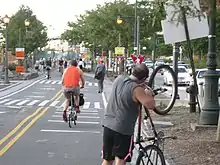
Components
Hudson River Greenway
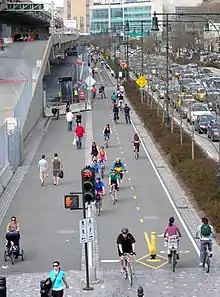
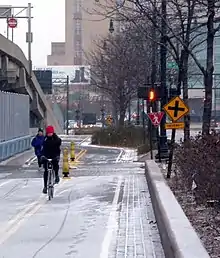
The Hudson River Greenway is the longest greenway in Manhattan, running along the West Side, from Dyckman Street in the north to Battery Park in the south, mostly through Riverside Park and Hudson River Park. A gap in West Harlem was filled in early October 2008 with the opening of the Harlem Piers bike lane. A roughly 10-block detour in the west 80s, where a walkway had crumbled into the river in the late 20th century,[1] was eliminated on May 20, 2010, when the rebuilt section of greenway was opened.[2]
The Hudson River Greenway is the most heavily used bikeway in the United States.[3] The majority of it is close to Hudson River water level, except the portion north of George Washington Bridge where it climbs steeply, to approximately 160 feet (49 m) and includes Inspiration Point, with views of The Palisades in New Jersey across the river and of the George Washington Bridge to the south. The Hudson River Greenway is part of the East Coast Greenway, a 3,000-mile (4,800 km) trail system connecting Maine to Florida, and is also part of the statewide Empire State Trail, forming its southernmost portion.
At the downtown end, the Battery Bikeway connects the Hudson and East River Greenways.[4] It opened in 2015 after renovation work on the South Ferry/Whitehall Street station.[5] The connection is a biker crossing right of way across Battery Place to the foot of the Hudson River Greenway.[4] At the Battery's southeast end, the bikeway continues as the East River Greenway, which runs next to FDR Drive.[6]
Travelers to Brooklyn use a bike lane in Warren Street and a one-way bike path (opened in September 2008) through the north end of City Hall Park to connect to the Brooklyn Bridge. Those arriving from Brooklyn use lanes in Park Row and Murray Street to reach the Greenway.[6]
Mixed-use paths continue a mile north from Dyckman Street into Inwood Hill Park alongside the western ball fields, at which point the path crosses the Amtrak rail tracks using a bridge with steps. This continues northeast into the park as part of the park trail system and connects north to bikeways in Spuyten Duyvil in the Bronx via the Henry Hudson Bridge, and east to the bike lane on 218th Street leading to the Broadway Bridge.[6]
The Harbor Ring is an initiative to create a 50-mile (80 km) bike route along the Lower Hudson River, Upper New York Bay, and Kill van Kull that would incorporate bike paths along the Greenway.[7][8][9]

An attack on the Greenway on October 31, 2017 killed six tourists and two local people; the perpetrator was an Uzbek-American and he used a Home Depot truck in the attacks.
East River Greenway
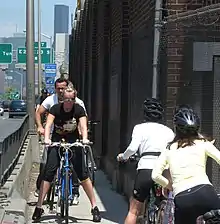
This runs along the East Side, from Battery Park and past South Street Seaport to a dead end at 125th Street, East Harlem with a 1.3 miles (2.1 km) gap from 34th to 60th streets in Midtown where pedestrians use busy First and Second Avenues to get around United Nations Headquarters between the Upper East Side and Kips Bay portions of the Greenway.
Some places are narrow due to sinkholes being blocked off by protective fencing, and the Captain Patrick J. Brown Walk squeezes between the highway and the dock of Con Edison's East River Station, requiring slower speeds. Other parts are shared space with motor access to Waterside Plaza (at Stuyvesant Cove Park), or a filling station. Approximately a mile near the southwest end is in the shadow of the elevated FDR Drive. This part is to be improved by the East River Esplanade project.
In the summer of 2008 the East River Greenway, along with the Brooklyn Heights Promenade, provided viewing locations to see the New York City Waterfalls.
In October 2011, the city and state reached an agreement to use the western portion of Robert Moses Playground for an expansion of the United Nations campus. In exchange, the United Nations Development Corporation would pay $73 million to fund the development of the gap in the Greenway between 38th and 60th streets.[10] In April 2017, the city committed $100 million in funding toward building this part of the greenway.[11]
Harlem River Greenway
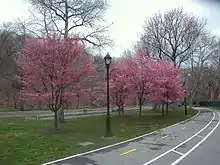
Partially following the route of the old Harlem River Speedway, the Harlem River Greenway is the shortest portion of the Manhattan Waterfront Greenway and is completely uninterrupted, running north through lower Highbridge Park from 155th Street, at the north end of Harlem, to Dyckman Street in northern Manhattan. It lies between the Harlem River and Harlem River Drive.[12] Users of the East River Greenway must use ordinary streets through East Harlem to reach this portion. A bike lane in Dyckman Street through Inwood connects to Inwood Hill Park and the Hudson River Greenway via a 2015 bike ramp at the western end of Dyckman Street.[13][14]
A second, shorter Harlem River greenway is in Harlem River Park, running from about 133rd Street in the south to 145th Street in the north. Access to the greenway is via walkways at 135th, 139th, and 142nd streets. The city has proposed to extend Harlem River Park south to 125th Street, where the greenway could connect to the East River Greenway.[15]
U-shaped barrier
There are plans for a new storm barrier along the southern third of the greenway, between West 57th and East 42nd Streets.[16][17][18] The final proposal, which is geographically U-shaped, will include many features.[16] Under the elevated FDR Drive structure above South Street will be storm barriers hanging from the viaduct's ceiling, which will drop down in case of a storm.[16] A "Battery Berm" will be located at Battery Park, and a maritime museum will be opened on the site of a former Coast Guard building there.[16] The proposal, by Rebuild by Design, will also include components for storm barriers in Hunts Point, Bronx and on Staten Island.[18]
The first component, a 2.19-mile-long (4 km) barrier on the Lower East Side between Montgomery and East 13th Streets called "The Bridging Berm", will cost $335 million.[19] In addition to storm protection, the berm—the first of three of the barrier's components—will also provide a pedestrian pathway and bikeway on top of berm, boating and fishing docks, a slope down to current sports fields, upgraded ADA-accessible ramps for bridges across the FDR Drive, and construction materials such as "slurry walls, concrete blocks, a compacted embankment, a clay cap, topsoil and salt-tolerant landscaping."[19] The berm bikeway will make a second connection between the Hudson and East River Greenways (the first being the Battery Bikeway).[20][21] The total cost of the project is over $3.5 billion.[22]
In March 2019, mayor Bill de Blasio announced a Lower Manhattan Coastal Resiliency Plan, which would create barriers and possibly extend the shoreline at a cost of $10 billion.[23][24] At the time, four of the project's phases had funding and were set to start construction between 2020 and 2021. The projects include berms as well as retractable dams and barriers in Battery Park City, the Financial District, and Two Bridges.[25] In 2019, the city installed a temporary barrier while the permanent barrier is being erected.[26]
References
Notes
- "Mayor Bloomberg And Commissioner Benepe Break Ground On Riverwalk In Riverside Park" (Press release). New York City Department of Parks & Recreation. October 17, 2007. Retrieved February 26, 2010.
- First Look: Detour No More on the Hudson River Greenway, Streetsblog, May 20, 2010, retrieved May 23, 2010
- "Statement of Noah Budnick, Deputy Director for Advocacy, Transportation Alternatives to the New York City Hudson River Park Trust Public Meeting and Hearing on Pier 40 Redevelopment", Transportation Alternatives, May 3, 2007. Accessed September 25, 2007. "The Hudson River Greenway is the most heavily used bike path in the United States, it is a 24-hour, 365 day a year route."
- "Battery Bikeway - A New York Bike Path". The Battery. Retrieved May 14, 2019.
- "Battery Town Green and Battery Bikeway Construction : NYC Parks". www.nycgovparks.org. Retrieved May 14, 2019.
- "NYC DOT - Bicycle Maps" (PDF). nyc.gov. New York City Department of Transportation. 2019. Retrieved May 14, 2019.
- Cruz, Vera (February 24, 2013). "New York Harbor and New Jersey meet Bike and pedestrian route planned to encourage recreation and transportation". Hudson Reporter. Archived from the original on November 29, 2014. Retrieved 2013-03-19.
- "The Harbor Ring". Transportation Alternatives. Retrieved 2013-03-19.
- Goodyear, Sarah (October 12, 2012). "Could You One Day Ride Your Bike All the Way Around New York Harbor?". Atlantic Cities. Retrieved 2013-03-19.
- Orden, Erica (October 6, 2011). "Greenway Plan Gets 'Missing Link'". The Wall Street Journal. Retrieved October 6, 2011.
- Maslin Nir, Sarah (2017-04-25). "City Commits $100 Million to Narrowing a Gap in Manhattan Greenway". The New York Times. ISSN 0362-4331. Retrieved 2017-04-26.
- Hibridge Park"1 MB". Missing or empty
|url=(help)1 MB nycparks.gov - "Cycling the Manhattan Waterfront Greenway". The New York Times. May 5, 2011.
- "Long-Awaited Ramp to Hudson River Greenway Opens on Dyckman Street". DNAinfo.com. September 17, 2015. Archived from the original on November 22, 2015.
- "Discuss The City's Planned Harlem Greenway Link Next Week". Harlem, NY Patch. 2017-09-13. Retrieved 2018-03-25.
- "Rebuild by Design – BIG U". Rebuildbydesign.org. Retrieved 2014-06-11.
- BIG Team Final Proposal pdf
- Beck, Graham T. (2014-04-08). "New York Unveils Dramatic New Storm-Protection Proposals – Next City". Nextcity.org. Retrieved 2014-06-11.
- Beck, Graham T. (2014-06-04). "New York's New $335 Million Storm-Surge Barrier Will Transform the Lower East Side – Next City". Nextcity.org. Retrieved 2014-06-11.
- https://ny.curbed.com/2012/8/6/10343460/trans-manhattan-bikeways-to-be-joined-in-battery-park
- http://thebattery.org/destinations/bikeway/
- Rogers, Josh (2011-05-11). "City floats new version of 'Seaport City,' but Lower Manhattan committee asks for storm help now". Downtown Express. Archived from the original on 2014-07-01. Retrieved 2014-06-11.
- Brody, Leslie (March 14, 2019). "New York City Plans Expansion of Lower Manhattan Shoreline to Prevent Flooding". WSJ. Retrieved May 6, 2019.
- Glassman, Carl (March 15, 2019). "Shoreline Expansion in City's Proposal for Lower Manhattan Flood Resiliency". Tribeca Trib Online. Retrieved May 6, 2019.
- "Lower Manhattan Coastal Resiliency". NYCEDC. April 8, 2019. Retrieved May 6, 2019.
- "6 Years After Hurricane Sandy, Here's What They Came Up With: Really Big Sandbags". The New York Times. May 5, 2019. Retrieved May 6, 2019.
External links
| Wikimedia Commons has media related to Manhattan Waterfront Greenway. |
East River Greenway: